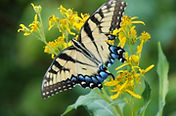Park Activities
Calendar of Events
Volunteer Programs
Sky Meadows Park
Location
Geography
Habitats
Trails
Visiting Park
Crooked Run Valley
Special Projects

Seasonal Observations - Summer, 2019
August may be the best month to see Sky Meadows many butterflies.
Included among the butterflies fluttering about - variegated fritillary (Euptoieta claudia), spring azure (Celastrina "ladon"), and silver-spotted skipper (Epargyreus clarus). Cabbage whites (Pieris rapae) are prolific (the most common butterfly encountered) while the spring azure is a close second. Several specimens of sleepy orange (Abaeis nicippe) can be found wherever thistles are present (and this is much of the park). The eastern tiger swallowtail (Papilio glaucus) can also be observed where thistle is in bloom and several monarchs (Danaus plexippus) were also encountered in the first week of August, often in close association with eastern tiger swallowtail. Specimens are large and easy to identify.
An occasional to rare sighting of a gray hairstreak (Strymon melinus) is always a pleasure and proved to be a difficult subject to photo-graph.
Spotted jewelweed (Impatiens capensis), also called orange jewelweed, is blooming extensively and can be found in the lower portions of the park, usually in moist conditions. The Turner Pond area has some fine specimens as well as the entrance area to Sherman Mills Trail.
The attractive Allegheny monkeyflower (Mimulus ringens) is now in bloom; it faintly resembles a small version of showy orchis. A darker blooming flower is asiatic dayflower (Commelina communis), which will bloom for abou the same time as the monkeyflower.
Butterfly milkweed, also called orange milkweed, (Asclepias tuberosa) has been reintroduced into Sky Meadows and can be found with the purple coneflower and smooth oxeye off Edmonds Road. Butterfly milkweed has not yet been included in the Inventory of Forbs/Herbs. Butterfly milkweed is easily differentiated from other milkweeds by its bright orange flowers.
A few swamp milkweed (Asclepias incarnata) are still blooming and can be observed through much of the lower park's open spaces particularly near Turner's Pond and near Gap Run.
Smooth oxeye (Heliopsis helianthoides) and blackeyed susan (Rudbeckia hirta) are both now in bloom. These large yellow petal flowers can be seen in the open lower meadow/field areas of the park. Smooth oxeye is a recent introduction into the park and can be found in the same area as purple coneflower. Blackeyed susan can be seen in the picnic area near the entrance to the park.
With its many fascinatng local common names (e.g., devil's guts and old man's night cap) the pure white hedge bindweed vine (Calystegia sepium) can be best be seen on Sherman's Mill Trail, usually at the beginning of the trail near the parking area.
Two species of the Potato Family are currently in bloom - horse nettle (Solanum carolinense) and climbing nightshade (Solanum dulcamara).
The fierce looking teasel (Dipsacus fullonum) is in bloom. Next to the thistles, teasel if one of the most formidable species of Sky Meadows.
The very familiar chicory (Cichorium intybus) can be found in small numbers in the picnic area of the park, often close to the road and parking areas and sometimes near Turner Pond. Extremely common throughout northern portions of Virginia, this introduced species has not made significant inroads into Sky Meadows.
There are several species of mint in Sky Meadows and not all of them have been sufficiently studied. In particular, members of the Pycnanthemum Genus can be difficult to identify. As noted in the Atlas of Virginia Flora, "A very problematic taxon. Forms . . . are similar to, and have been confused. . . ; hybrids may further confound identification. VA material needs critical evaluation." At least one mint has been observed with broad toothless leaves, a configuration that does not precisely fit any of the known mints in Facquier County with the possible exception of short-toothed mountain mint (Pycnanthemum muticum).
Wild bergamot (Monarda fistulosa) is now beginning to bloom in the same vicinity as purple coneflower. While wild bergamot is similar to basal bee-balm (Monarda clinopodia), the color of their tubed flowers is differrent, with bee-balm flowers more reddish/scarlet while wild bergamot more pinkish or pale lilac.
Heal-all (Prunella vulgaris) is beginning to bloom. This is a very beautiful species has a light purple upper lip that functions as a hood, while the lower lip is white and fringed.
Bladder campion (Silene vulgaris)with its bladder-like calyx that is pale green to dull pink is beginning to bloom. This species of the Pink Family is related to chickweeds.
In the same Pink Family as bladder campion, bouncing bet (Saponaria officinalis) is abundant in the lower, wetter portions of the park, particularly as you enter the Lost Mountain section of Sky Meadows near Gap Run.
All reptiles and amphibians are now out and, with some luck, visible.
Skinks in general, and turtles at Turner Pond are and will continue to be very obvious.
The eastern box turtle (Terrapene carolina carolina) is a common sight, both in water and sunning themselves on the rock island at the northwest corner of Turner Pond, while the less frequently seen eastern snapping turtle (Chelydra serpentina serpentina) can also be occassionally observed.
Bees are numerous although not always easy to identify. The European honey bee (Apis mellifera) is common as are members of the Bombus Genus (bumble bees).
